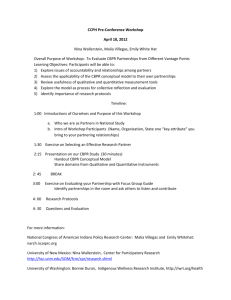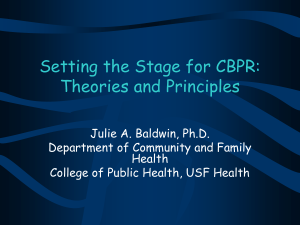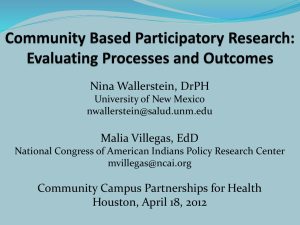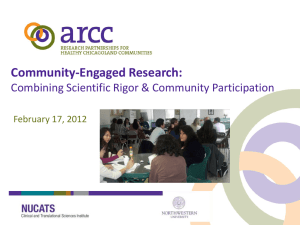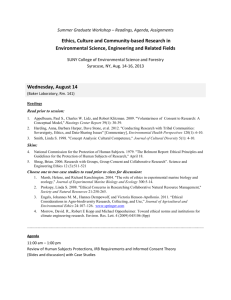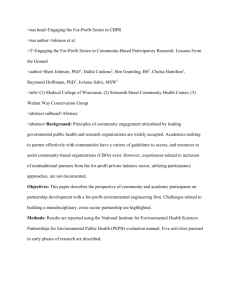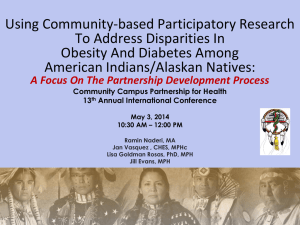Recent Publications Regarding CBPR
advertisement
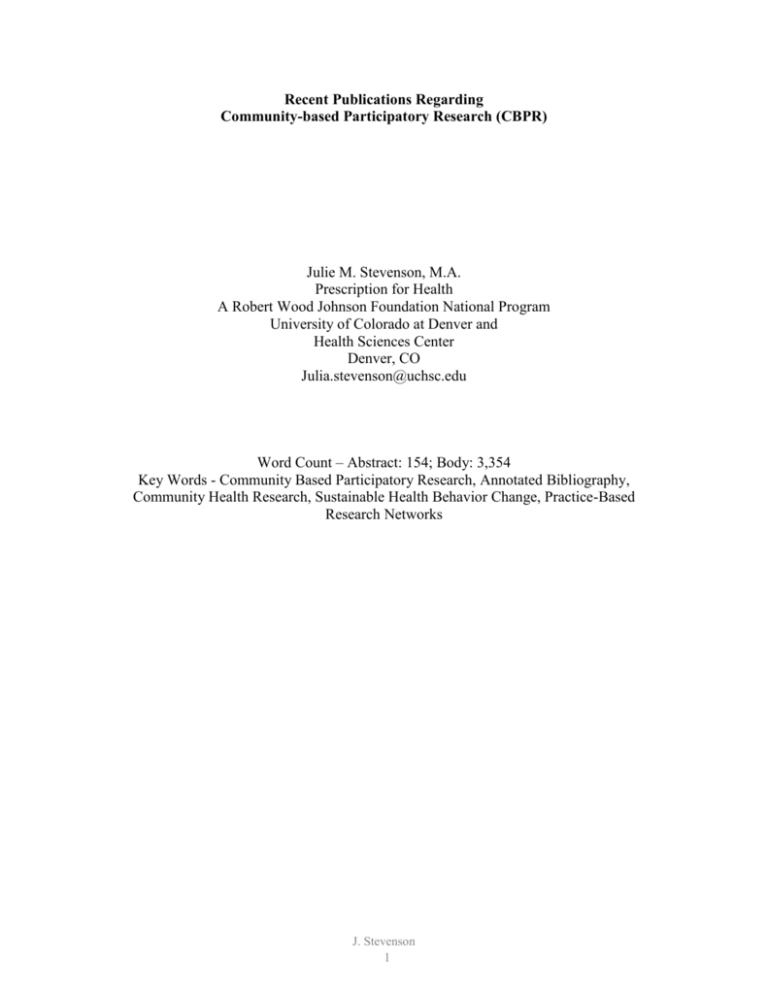
Recent Publications Regarding Community-based Participatory Research (CBPR) Julie M. Stevenson, M.A. Prescription for Health A Robert Wood Johnson Foundation National Program University of Colorado at Denver and Health Sciences Center Denver, CO Julia.stevenson@uchsc.edu Word Count – Abstract: 154; Body: 3,354 Key Words - Community Based Participatory Research, Annotated Bibliography, Community Health Research, Sustainable Health Behavior Change, Practice-Based Research Networks J. Stevenson 1 Abstract There is a peculiar gap in the US health care system between biomedical research, everyday medical care, and improved health outcomes. The individuals and communities that participate in research often fail to see the results and outcomes of the very projects in which they invested time, energy, and personal risk. One solution to this disconnect may be Community-based Participatory Research (CBPR), an evolving research methodology in which community members and researchers collaborate to improve health. This annotated bibliography was created to educate the reader about the history, definition, key components, execution, and utility of CBPR in a variety of populations. In it one will also find references to articles that provide insight, hints and tips from experienced researchers who have conducted CBPR. This document is intended to serve as a reference point to a wealth of information for the person wishing to effect patient care, outcomes and sustainable health behavior change in the community. J. Stevenson 2 Recent Publications Regarding Community-based Participatory Research (CBPR) Community-Based Participatory Research (CBPR) is rapidly becoming an important research methodology throughout academic and community research organizations. One barrier to full implementation of CBPR is the general lack of knowledge on CBPR, its purpose, methods, and outcomes. This document distills the hundreds of articles written about CBPR into a short annotated bibliography that highlights the major contributions of CBPR. Unifocal in nature, the purpose of this annotated bibliography is to serve as a resource for persons interested in pursuing knowledge of CBPR. One will find references to articles that aim to educate the reader on a continuum: The history, definition, key components, policy, execution, evidence, successes and lessons learned surrounding CBPR lie in the references found herein. Reviewing the literature and scrutinizing the evidence of CBPR clearly reveals the usefulness of this research method. The current state of the literature is undersupplied with CBPR projects that are based on comparison with control groups. Persons who practice or read of CBPR probably need to expand the definition of ‘significant findings’ to include successful implementation based on the feedback of persons who are the experts on their own behavior. Adhering to the basic tenets of CBPR when attempting to create sustainable health behavior change in communities can cause something remarkable to unfold: Investigators join with community members to hone in on the most pertinent health behavior change to be addressed; unique research projects and group relationships blossom; mutual appreciation between science and community ensues; and, researchers and community members alike find benefit from outcomes. As will become evident in this guided tour of CBPR, its usefulness can be observed among a variety of research questions and populations, and yet it currently remains underutilized. The search engine used to retrieve articles regarding CBPR was Ovid MEDLINE In-Process & Other Non-Indexed Citations, Ovid MEDLINE Daily and Ovid MEDLINE 1966 to present, accessed through the Department of Family Medicine at the University of Colorado at Denver and Health Science Center. The search criteria were limited to the last ten years (1996-2006), with the exception of one foundational 1994 publication. Using the search term ‘community-based participatory research’ resulted in over 120 articles. These articles were screened based on relevance to the audience of this annotated bibliography. Initial screening left a total of 50 research articles, publications and reviews. Other sources of literature included research referenced to in the articles reviewed and helpful suggestions from colleagues. A total of twenty-one articles comprise this annotated bibliography. J. Stevenson 3 I. The following articles may be a useful place to start one’s investigation of CBPR. In the following resources lies the definition of CBPR, key components of practicing CBPR, and comprehensive literature reviews for further systematic inquiry. Upon exploration of these references, the reader will discover tools such as measures, guidelines, policies and examples that aid in the understanding of CBPR, its utility and its challenges. Green LW, George MA, Daniel M, Frankish CJ, Herbert CJ, Bowie WR, ONeill M. Study of Participatory Research in Health Promotion. Ottawa: Royal Society of Canada;1994:128 The history and core elements of CBPR launch this report, which is a product of CBPR literature and research studies originally compiled with the intent of providing a tool for research funding agencies. In answer to the need for what uniformity there is to be had in conducting CBPR, an array of experts systematically investigated hypothetical guidelines for persons proposing and delivering CBPR. The end result is a working definition of CBPR and a validated checklist that can be utilized to evaluate and measure the degree to which a research project demonstrates the foundational principles of participatory research. Green and colleagues also suggest a number of recommendations for strengthening participatory research. Frankish CJ, George A, Daniel M, Doyle Waters M, Walker M. Participatory Health Promotion Research in Canada: A Community Guidebook. Ottawa: Royal Society of Canada;1997:59. Frankish and colleagues present a concise guidebook useful for community groups practicing CBPR that complements Green et al’s (1994) report on the Study of Participatory Research in Health Promotion. Expounding on points made by Green and colleagues, Frankish and colleagues challenge the reader with questions that the community group can ask of the CBPR strategies being utilized in order to ensure best practice. Frankish and colleagues also provide case studies as examples of how select Canadian CBPR projects have incorporated community involvement, developed research questions, demonstrated usefulness to the community, and shared results. Israel BA, Schulz AJ, Parker EA, Becker AB. Review of Community-based Research: Assessing partnership approaches to improve public health. Annu Rev Public Health. 1998;19:173-202. In this review of CBPR literature, Israel and colleagues provide a knowledge-base of CBPR resources and the health disparities it seeks to negate. Key principles of community-based research are presented, rationale for community-based research is synthesized and specific factors involved in conducting CBPR are discussed. Challenges faced by researchers engaged in collaborative efforts are detailed, and the authors suggest strategies for overcoming barriers and limitations of CBPR. Minkler M, Wallerstein N. Community-Based Participatory Research for Health. San Francisco, CA: Jossey-Bass;2003:490. Minkler and Wallerstein brought together a number of experienced persons to educate the reader on CBPR from its roots to its application in a variety of populations. J. Stevenson 4 The reader is given insight into identifying community issues as well as strengths. Development and ethical challenges that may be present when practicing CBPR are discussed. Examples of the use of CBPR in diverse populations are provided. Finally, the ways in which social policy may be changed by utilizing CBPR is presented and exemplified. The reader is left with guidelines, resources and policy principles of CBPR, among other tools. Viswanathan M, Ammerman A, Eng E, Gartlehner G, Lohr KN, Griffith D, Rhodes D, Samuel-Hodge C, Maty S, Lux L, Webb L, Sutton SF, Swinson T, Jackman A, Whitener L. Community-Based Participatory Research: Assessing the Evidence. Evidence Report/Technology Assessment No. 99 (Prepared by RTI-University of North Carolina Evidence-based Practice Center under Contract No. 290-02-0016). AHRQ Publication 04-E022-2. Rockville, MD: Agency for Healthcare Research and Quality. July 2004. The authors performed a systematic literature review in order to define CBPR, assess the quality of CBPR projects already implemented, discover evidence supporting the efficacy of CBPR, and clarify criteria for persons reviewing CBPR grant proposals. This review provides a helpful analytic framework and details critical elements of CBPR including application, community benefits, research benefits and research challenges. II. The following references may be helpful for the individual wishing to discover what policies and guidelines have been created to lead persons through successful utilization of CBPR: Macaulay M, Commanda LE, Freeman WL, Gibson N, McCabe ML, Robbins CM, Twohig PL. Responsible research with communities: Participatory research in primary care. NAPCRG Policy Statement, 1998. Available: http://www.napcrg.org/responsibleresearch.pdf. Advocating the use of participatory research (PR) in the primary care setting, Macaulay and colleagues pose support for the validity and scientific nature of the PR approach. This organizational policy statement provides suggestions for establishing PR, a discussion of ethical responsibilities of persons practicing PR and touches on conflict resolution. Macaulay and colleagues also summarize a number of PR projects. Finally, recommended guidelines for conducting responsible research are presented that include promotion of ethical research, capacity development and the development of guidelines within each PR project. Israel BA, Schulz AJ, Parker EA, Becker AB. Community-based Participatory Research: Policy recommendations for promoting a partnership approach in health research. Educ Health. 2001;14:182-197. Israel and colleagues present specific recommendations for policy change regarding the funding of CBPR projects. Directed at grant reviewers, funders, and academic institutions, this article identifies the need to create changes in the provision of grant funds to persons practicing CBPR. Some changes discussed include one-year planning grants, long-range funding and dispersing funds to community-based organizations and universities. Israel and colleagues also suggest that funders be willing J. Stevenson 5 to disperse grant money to persons practicing outside of traditional research methods. Finally, Israel and colleagues call for the necessity of CBPR education for researchers and community members through university courses and training programs. Hueston WJ, Mainous III AG, Weiss BD, Macaulay AC, Hickner J, Sherwood RA. Protecting participants in family medicine research: A consensus statement on improving research integrity and participants’ safety in educational research, community-based participatory research, and practice network research. Fam Med. 2006;38:116-120. A panel of experts in practice-based research networks (PBRNs), CBPR and educational research convened to discuss ways to protect participants and improve research integrity in these areas. In the first publication of its nature, Hueston and colleagues summarize the conclusions drawn by this panel along with the input of members of the North American Primary Care Research Group (NAPCRG) and the Society of Teachers of Family Medicine (STFM). Family medicine researchers and readers alike are provided 11 recommendations for research improvement. III. For the individual who desires to learn how CBPR has been executed, the following articles exemplify the process: Giachello AL, Arrom AO, Davis M, Sayad JV, Ramirez D, Nandi C, Ramos C. Reducing diabetes health disparities through Community-Based Participatory Action Research: The Chicago Southeast Diabetes Community Action Coalition. Public Health Rep. 2003;118:309-323. Outcomes of telephone surveys and focus groups conducted by trained community members are presented that offer evidence for the need for addressing health disparities experienced by Latino and African American persons in select areas of Chicago. Based on the findings, the Chicago Southeast Diabetes Community Action Coalition created an action plan purported to change the community members’ experience of diabetes using health service providers, schools, business, labor unions and the community members themselves. Although specific details regarding the action and evaluation phases are not discussed by Giachello and colleagues in this article, the reader is presented with the process and utility of collecting pertinent data from the community that CBPR seeks to benefit. McAllister CL, Green BL, Terry MA, Herman V, Mulvey L. Parents, practitioners, and researchers: Community-Based Participatory Research with Early Head Start. Am J Public Health. 2003;93:1672-1679. McAllister and colleagues describe the ways in which CPBR was utilized with an Early Head Start program in Pennsylvania. The numerous ways in which collaboration was achieved among researchers, Early Head Start practitioners, and parents of the communities’ children is the focal point of this article. Beneficial outcomes of the collaborations are presented, such as formal and informal conversations within focus groups and between community members and researchers that added unforeseen expansions to the original research question. Moreover, the unique contribution of the community-members’ insight created changes in data collection methods and scale J. Stevenson 6 design. In addition to discussing the beneficial findings of this CBPR project, McAllister and colleagues outline the elements necessary to address in order for CBPR to continue into the future. Horowitz CR, Arniella A, James S, Bickell NA. Using Community-based Participatory Research to reduce health disparities in East and Central Harlem. Mt Sinai J Med. 2004;71:368-374. Horowitz and colleagues delineate the development and implementation of CBPR in two underserved US inner-city communities via a federally-funded center that allows for a congregation of community members, researchers, policy makers and clinicians to develop programs to eliminate health disparities. To create sustainable change, individuals who were both community members and experienced with chronic illness were taught illness self-management and were then asked to lead peer-education programs. Although outcomes are not presented, this article provides a detailed example of the implementation of CBPR. Horowitz and colleagues discuss the challenges faced in conducting CBPR, the appreciation for cultural differences gained by members of the CBPR group, the education received surrounding effective communication skills among persons of differing ethnic backgrounds, and the importance of sustained relationships between researchers and committee members to make future research more practical. McQuiston C, Parrado EA, Phillips Martinez A, Uribe L. Community-Based Participatory Research with Latino community members: Horizonte Latino. J Prof Nurs. 2005;21:210-215. McQuiston and colleagues detail the use of CBPR in response to a request for grant applications. By utilizing CBPR with a diverse group of Latino-American immigrants, academics and community members worked together to determine willingness of all parties to pursue an investigation into risky health behavior in the community. Community members also worked with academics to determine the themes to be explored in the research. A number of specific comments from community members regarding contributing factors to the community issue at hand are revealed in this article, and feedback from these participants is laced throughout. The results of collaborative identification of the community issues were the development of a proposal and a theory of community-specific HIV risk. Mosavel M, Simon C, van Stade D, Buchbinder M. Community-based Participatory Research (CBPR) in South Africa: Engaging multiple constituents to shape the research question. Soc Sci Med. 2005;61:2577-2587. Mosavel and colleagues conducted extensive focus groups with female adolescents, mothers, local health professionals, school and local government members, service providers, clinic workers, traditional healers and health promotion organizations to address cervical health issues in South Africa. An example of the research question development phase of CBPR, this article details the extensive measures taken to ensure informed consent, the method of developing focus group questions with community members, the types of community members involved in subsequent focus groups and the sensitive social dynamics taken into consideration during focus group proceedings. J. Stevenson 7 Mosavel and colleagues also detail the process undertaken to understand the community in which intervention is intended to be delivered. Westfall JM, VanVorst RF, Main DS, Herbert C. Community-based Participatory Research in Practice-Based Research Network. Ann Fam Med. 2006;4:8-14. Supplemental case report [The High Plains Research Network Community Advisory Council. Community involvement in a practice-based research network. Available at: http://www.annfammed.org/cgi/data/4/1/8/DC1/. Accessed June 2006. In this supplemental case report, Westfall and colleagues detail the use of a Community Advisory Council (CAC) in the High Plains Research Network PBRN. Recruitment methods, members’ role in the community and a number of the CAC’s activities are discussed. Westfall and colleagues present the reader with the elements necessary to the success of the CAC, as well as the benefits and challenges of the project. IV. For the person who seeks evidence of the utility of CBPR, the following articles may be of interest1: Plescia M, Groblewski M. A community-oriented primary care demonstration project: Refining interventions for cardiovascular disease and diabetes. Ann Fam Med. 2004;2:103-109. Plescia and Groblewski provide an example of the utilization of grassroots community activists in administration of surveys to determine community members’ health behaviors and perception of powerful others’ locus of control. Data were presented to a representative community board who offered valuable insight into the quality and accuracy of the responses. Results of the survey revealed barriers to health behavior change as well as members of the local community (i.e., ministers, physicians) who are perceived as powerful others. Such information is useful for intervention planning. This article is an example of the utilization of community members in evaluating the current status of health behavior in the studied community and in discovering potential avenues for future health behavior change interventions. Edgren KK, Parker EA, Israel BA, Lewis TC, Salinas MA, Robins TG, Hill YR. Community involvement in the conduct of a health education intervention and research project: Community Action Against Asthma. Health Promot Pract. 2005;6:263-269. Edgren and colleagues describe the utility of a Steering Committee, consisting of community members from Detroit, in all aspects of the research process for a complex, multi-faceted childhood asthma intervention study. Concrete examples of the benefits of utilizing CBPR are discussed in this article. For example, Edgren and colleagues noted bi-directional beneficial outcomes of utilizing community members including cultural/community sensitivity and expanded job opportunities for community members who were recruited to be interviewers. Further, seeking opinions from community members allowed for greater insight into the challenges that might present themselves 1 Please refer to Appendix A for a list of additional articles reviewed but not included in this annotated bibliography. CBPR has not been successful in every instance of its use. J. Stevenson 8 throughout the study. Community-member foresight, along with the relative ease of developing rapport unique to persons with whom participants could relate to, resulted in remarkably high retention rates given the demands of this study. Edgren and colleagues leave the reader with recommendations for persons interested in utilizing CBPR based on their experience with this study. Minkler M. Community-based Research Partnerships: Challenges and Opportunities. J Urban Health. 2005;82:ii3-12. After briefly educating the reader of the history of CBPR, Minkler discusses the value that CBPR offers to health research using specific evidence from global studies as examples of its worth. Minkler further refers to global projects to highlight the ethical challenges that persons face when utilizing CBPR. Pulling from sources that were faced with the ethical challenges discussed, Minkler leaves the reader with suggestions for overcoming a number of ethical challenges found in CBPR. V. For persons wishing to learn from the wisdom of those who have studied and/or practiced CBPR, the following articles offer insight into its challenges and obstacles. Not to be discouraged, many articles provide suggestions to overcoming existing barriers to enable CBPR: Metzler MM, Higgins DL, Beeker CG, Freudenberg N, Lantz PM, Senturia KD, Eisinger AA, Viruell-Fuentes EA, Gheisar B, Palermo A, Softley D. Addressing urban health in Detroit, New York City, and Seattle through Community-based Participatory Research partnerships. Am J Public Health. 2003;93:803-811. The Center for Disease Control (CDC) established urban research centers (URCs) in three major US cities with the intent to conduct applied public health research with diverse populations via CBPR. This article is an evaluation of the activities conducted at the URCs during a 4 year time span (1995-1999), an analysis of outcome data of the CBPR partnerships, and a candid look at challenges in developing CBPR through URCs. Highlighted are key points to successfully implementing CBPR, such as definition of procedure, shared decision-making, definition of collaboration, determination of research priorities, and secure acquisition of funding. Principles of collaboration are presented and the importance of a governing structure is suggested. While specifics of the CBPR activities and outcomes are scarce, implementation challenges and key points for success are presented. Parker EA, Israel BA, Williams M, Brakefield-Caldwell W, Lewis TC, Robins T, Ramirez E, Rowe Z, Keeler G. Community Action Against Asthma: Examining the partnership process of a Community-Based Participatory Research project. J Gen Intern Med. 2003;18:558-567. Parker and colleagues present a process evaluation of the Community Action Against Asthma (CAAA) CBPR project. Qualitative interviews were conducted with 22 members of the CAAA Steering Committee in order to determine the extent to which CBPR principles were adhered to during the implementation of CAAA’s intervention. Parker and colleagues chart the process of problem identification, research design and project start-up for the formation/mobilization stage and the implementation stage of the J. Stevenson 9 first two years of the five-year CAAA project. Specific examples of survey responses from community members personalize and enhance the understanding of the successes and challenges found in practicing CBPR. Based upon their process evaluation of CAAA, Parker and colleagues leave the reader with recommendations for successful establishment and perpetuation of CBPR collaborations. Ahmed SM, Beck B, Maurana CA, Newton G. Overcoming barriers to effective Community-based Participatory Research in US Medical Schools. Educ Health (Abingdon). 2004;17:141-151. Ahmed and colleagues detail institutional and personal barriers regarding the integration of CBPR into medical academic culture. A philosophical and a practical paradigm shift are provided that give the reader a tangible conceptual reference for higher education change. By presenting the reader with specific barriers, providing concrete ways to overcome obstacles and sharing enthusiasm for the value of CBPR, the authors leave the reader with a resource for incorporating CBPR into medical institutions. Westfall JM, VanVorst RF, Main DS, Herbert C. Community-Based Participatory Research in Practice-Based Research Networks. Ann Fam Med. 2006;4:8-14. Westfall and colleagues investigated the extent to which practice-based research networks (PBRNs) in the United States utilize CBPR methods. Westfall and colleagues asked PBRNs to complete a questionnaire that, based on the Agency for Research and Health Quality’s (AHRQ) definition of community involvement, assessed the extent to which each PBRN surveyed involved community members and patients in their research. Forty-six PBRNs responded to the survey. Of the 46 respondents, 26 self-reported that they met the AHRQ’s criteria for CBPR in PBRNs. In the first article of its nature, Westfall and colleagues discuss the extent to which CBPR has been integrated into PBRNs thus far, the value found in incorporating CBPR into PBRNs, the challenges faced by the PBRNs utilizing CBPR methods, and potential for perpetuating CBPR into the future of PBRNs. J. Stevenson 10
